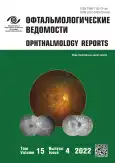The effect of retinal perfusion on the bioelectric activity of the retina in full-thickness macular holes
- Authors: Doktorova T.A.1,2, Suetov A.A.1,3, Boiko E.V.1,2, Sosnovskii S.V.1
-
Affiliations:
- S.N. Fyodorov Eye Microsurgery Federal State Institution, St. Petersburg Branch
- North-West State Medical University named after I.I. Mechnikov
- State Scientific Research Test Institute of Military Medicine
- Issue: Vol 15, No 4 (2022)
- Pages: 7-14
- Section: Original study articles
- URL: https://journals.rcsi.science/ov/article/view/144088
- DOI: https://doi.org/10.17816/OV111903
- ID: 144088
Cite item
Abstract
BACKGROUND: Information on retinal capillary perfusion in idiopathic full-thickness macular hole (FTMH) is limited, and there are no data on the possible effect of blood supply to individual areas and layers of the retina on their functional activity.
AIM: To study the relationship between vascular perfusion in the superficial and deep capillary plexuses (SCP and DCP) and the bioelectrical activity of the retina in full-thickness macular hole.
MATERIALS AND METHODS: Multifocal electroretinography (mfERG), optical coherence tomography (OCT), and OCT-angiography (OCTA) were performed in 18 eyes with FTMH and 10 intact eyes. In the projection of individual hexagons of the mfERG pattern, parameters of bioelectrical activity were compared with structural changes (hole, cystic changes), capillary density in the SCP and DCP.
RESULTS: In the FTMH group, the density of capillaries in the superficial capillary plexuses correlated with P1 implicit time in the R2 ring hexagons (R = –0.23, p < 0.05), in the hole zone and intraretinal cystic changes (R = –0.21 and R = –0.22, p < 0.05), P1 amplitude in the hole zone (R = 0.24, p < 0.05). In deep capillary plexuses, the capillary density correlated with N1 implicit time at the fixation point and the hole zone (R = –0.57 and R = –0.19, p < 0.05), P1 implicit time at the hole zone (R = –0.2, p < 0.05), P1 amplitude in the hexagons of the R2 and R3 rings (R = 0.46 and R = 0.44, p < 0.05), more pronounced in the hole zone and cystic changes (R = 0.54 and R = 0.29, p < 0.05).
CONCLUSIONS: There is a correlation between capillary perfusion in different layers of the retina and its bioelectrical activity in FTMH. A decrease in perfusion in the deep capillary plexus of the macula with a chronic macular hole may be a predictor of a low functional prognosis in the outcome of surgical treatment of FTMH.
Full Text
##article.viewOnOriginalSite##About the authors
Taisiia A. Doktorova
S.N. Fyodorov Eye Microsurgery Federal State Institution, St. Petersburg Branch; North-West State Medical University named after I.I. Mechnikov
Author for correspondence.
Email: taisiiadok@mail.ru
ORCID iD: 0000-0003-2162-4018
SPIN-code: 8921-9738
ResearcherId: GRS-5972-2022
Postgraduate Student, Ophthalmologist
Russian Federation, Saint Petersburg; Saint PetersburgAleksei A. Suetov
S.N. Fyodorov Eye Microsurgery Federal State Institution, St. Petersburg Branch; State Scientific Research Test Institute of Military Medicine
Email: ophtalm@mail.ru
ORCID iD: 0000-0002-8670-2964
SPIN-code: 4286-6100
Scopus Author ID: 36542999900
ResearcherId: AAI-4855-2020
МD, Cand. Sci. (Med.), Ophthalmologist, Senior Research Associate
Russian Federation, Saint Petersburg; Saint PetersburgErnest V. Boiko
S.N. Fyodorov Eye Microsurgery Federal State Institution, St. Petersburg Branch; North-West State Medical University named after I.I. Mechnikov
Email: boiko111@list.ru
ORCID iD: 0000-0002-7413-7478
МD, Dr. Sci. (Med.), Professor, Head of the Ophthalmology Department, Corresponding member of the Military Medical Academy, Director
Russian Federation, Saint Petersburg; Saint PetersburgSergei V. Sosnovskii
S.N. Fyodorov Eye Microsurgery Federal State Institution, St. Petersburg Branch
Email: svsosnovsky@mail.ru
ORCID iD: 0000-0001-8969-6240
МD, Cand. Sci. (Med.), Ophthalmologist, Deputy Director of Clinical Services
Russian Federation, Saint PetersburgReferences
- Duker JS, Kaiser PK, Binder S, et al. The international vitreomacular traction study group classification of vitreomacular adhesion, traction, and macular hole. Ophthalmology. 2013;120(12):2611–2619. DOI: 0.1016/j.ophtha.2013.07.042
- Forsaa VA, Lindtjørn B, Kvaløy JT, et al. Epidemiology and morphology of full-thickness macular holes. Acta Ophthalmol. 2018;96(4):397–404. doi: 10.1111/aos.13618
- Ezra E. Idiopathic full thickness macular hole: Natural history and pathogenesis. Br J Ophthalmol. 2001;85(1):102–108. doi: 10.1136/bjo.85.1.102
- Caprani SM, Donati S, Bartalena L, et al. Macular hole surgery: The healing process of outer retinal layers to visual acuity recovery. Eur J Ophthalmol. 2017;27(2):235–239. doi: 10.5301/ejo.5000905
- Nair U, Sheth JU, Indurkar A, Soman M. Intraretinal cysts in macular hole: A structure-function correlation based on en face imaging. Clin Ophthalmol. 2021;15:2953–2962. doi: 10.2147/OPTH.S321594
- de Carlo TE, Romano A, Waheed NK, Duker JS. A review of optical coherence tomography angiography (OCTA). Int J Retin Vitr. 2015;1(1):5. doi: 10.1186/s40942-015-0005-8
- Coscas F, Sellam A, Glacet-Bernard A, et al. Normative data for vascular density in superficial and deep capillary plexuses of healthy adults assessed by optical coherence tomography angiography. Investig Ophthalmol Vis Sci. 2016;57(9):211–223. doi: 10.1167/iovs.15-18793
- Shahlaee A, Rahimy E, Hsu J, et al. Preoperative and postoperative features of macular holes on en face imaging and optical coherence tomography angiography. Am J Ophthalmol Case Rep. 2017;5:20–25. doi: 10.1016/j.ajoc.2016.10.008
- Hoffmann MB, Bach M, Kondo M, et al. ISCEV standard for clinical multifocal electroretinography (mfERG) (2021 update). Doc Ophthalmol. 2021;142(1):5–16. doi: 10.1007/s10633-020-09812-w
- Premi E, Donati S, Azzi L, et al. Macular holes: main clinical presentations, diagnosis, and therapies. J Ophthalmol. 2022;2022:2270861. doi: 10.1155/2022/2270861
- Daruich A, Matet A, Moulin A, et al. Mechanisms of macular edema: Beyond the surface. Prog Retin Eye Res. 2018;63:20–68. doi: 10.1016/j.preteyeres.2017.10.006
- Bringmann A, Pannicke T, Grosche J, et al. Müller cells in the healthy and diseased retina. Prog Retin Eye Res. 2006;25(4):397–424. doi: 10.1016/j.preteyeres.2006.05.003
- Spaide RF. Retinal vascular cystoid macular Edema: Review and new theory. Retina. 2016;36(10):1823–1842. doi: 10.1097/IAE.0000000000001158
Supplementary files







